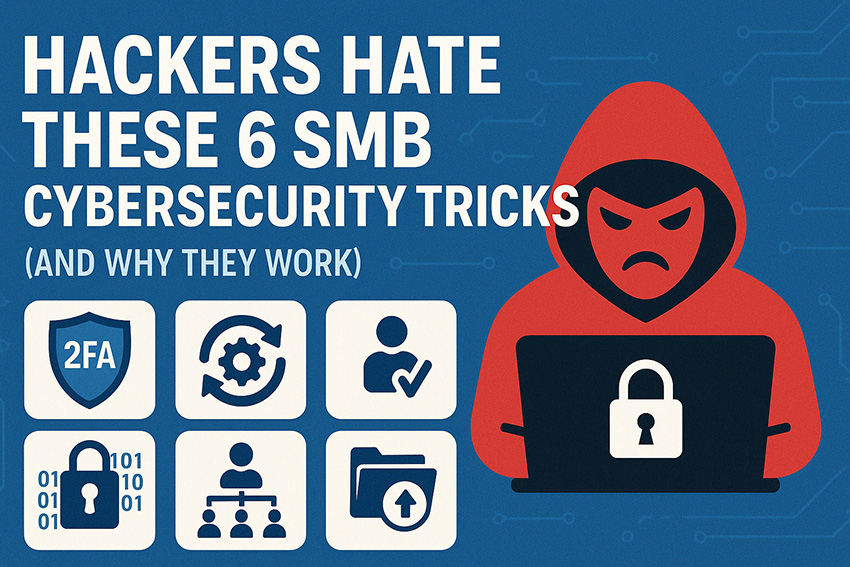
Hackers Hate These 6 SMB Cybersecurity Tricks (And Why They Work)
Small and midsize businesses (SMBs) are increasingly attractive targets for hackers. Why? Many SMBs have limited cybersecurity budgets, fewer resources, and often a dangerous “that won’t happen to us” mindset.
The good news: you don’t need a Fortune 500 budget to protect your business.
Here are six cost-effective, easy-to-implement cybersecurity strategies that hackers hate—because they actually work.


1. Two-Factor Authentication (2FA)
The #1 way hackers gain access to business accounts is through stolen passwords. Two-factor authentication (2FA) and multifactor authentication (MFA) add a critical second layer of defense by requiring both a password and a verification code (usually sent to your phone or email).
Even if a hacker gets your password, they can’t break through without the second factor.
Why It Works:
-
Simple to set up and often free through platforms like Google Workspace and Microsoft 365.
-
Reduces unauthorized account access dramatically.
Reality Check:
Despite its effectiveness, fewer than 34% of SMBs use MFA compared to 87% of large enterprises (JumpCloud, 2024). Don’t skip this easy win!
2. Regular Software Updates
Hackers love outdated software because it’s full of known vulnerabilities. Ransomware attacks often exploit flaws that were patched months ago.
What You Should Do:
-
Set systems and apps to auto-update.
-
Enforce employee compliance with update policies.
-
Consider temporarily restricting access for devices that skip critical updates.
Why It Works:
Most attacks rely on unpatched systems—closing these gaps keeps your business far safer.
3. Employee Cybersecurity Training
More than 90% of cyberattacks start with a phishing email (CISA). With AI making phishing emails harder to detect, employee training is more critical than ever.
Key Steps:
-
Conduct regular cybersecurity awareness training.
-
Include real-world phishing examples and simulated attacks.
-
Keep sessions short, interactive, and frequent.
Why It Works:
Training can reduce phishing risks from 32.5% to just 5% within 12 months (KnowBe4 Study).
4. Data Encryption
Data is one of your most valuable assets—and encryption ensures it’s protected, even if intercepted.
What Encryption Does:
-
Converts your sensitive data into unreadable code without the proper decryption key.
-
Protects emails, stored files, and customer information.
Good to Know:
Many modern platforms like Microsoft 365 and Google Workspace make encryption easy and affordable. Plus, most cybersecurity insurance policies now require encryption.
5. Limiting Employee Access
Giving every employee unrestricted access to sensitive files is a major security risk.
Best Practices:
-
Grant access only to what employees need to do their jobs.
-
Use temporary access permissions for special projects.
-
Regularly audit user permissions.
Why It Works:
Restricting access limits the potential damage from both accidental errors and insider threats.
6. Reliable Data Backups
Ransomware remains one of the biggest threats to SMBs. If hackers lock your files, your backup could be your only lifeline.
Follow the 3-2-1 Backup Rule:
-
Keep three copies of your data.
-
Store them on two different types of media.
-
Keep one copy off-site (cloud or disconnected external drive).
And Don’t Forget:
Test your backups regularly. A backup is worthless if it’s incomplete or corrupted when you need it most.
The Bottom Line
You don’t need a massive IT budget to make your business a hard target for cybercriminals. These six simple strategies are affordable, highly effective—and hated by hackers everywhere.
If any of these cybersecurity basics are missing from your business, now’s the time to take action.
Ready to strengthen your defenses?
Start with a FREE Network Assessment to identify vulnerabilities and get a customized cybersecurity plan tailored to your business.





